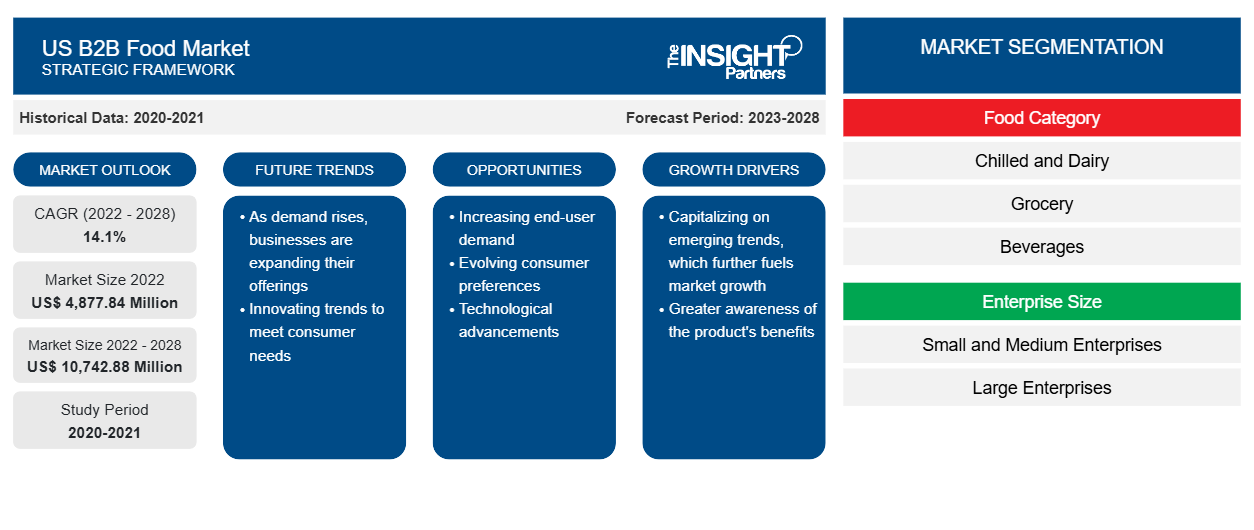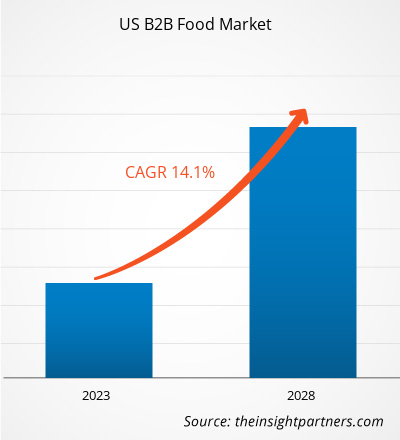The US B2B food marketplace platform market is projected to grow from US$ 4,877.84 million in 2022 to US$ 10,742.88 million by 2028; it is estimated to record a CAGR of 14.1% from 2022 to 2028.
Supply firms attract consumers by giving discounts or special deals on their products or when a certain volume is purchased. Suppliers and businesses frequently enter into enterprise-level pricing arrangements, and the market price of any given item is kept consistent. Price transparency is maintained in the food B2B sector as well. This dynamic typically benefits suppliers, who may adopt a price discrimination strategy based on customers' ability and willingness to pay. For example, eFoodChoice.com is a food B2B online platform firm that helps international food vendors and buyers expand their merchandising channels, develop their online business internationally, and sustainably increase their profitability. Depending on the quantity of the goods, the firm provides an exclusive pricing range for the buyers. The company has also set minimum order quantities (MOQs) for each product category. With such contractual pricing of products, end users can select the optimal number of goods at a fair price, in turn, triggering the demand for US B2B food marketplace platform market growth.
Customize This Report To Suit Your Requirement
You will get customization on any report - free of charge - including parts of this report, or country-level analysis, Excel Data pack, as well as avail great offers and discounts for start-ups & universities
US B2B Food Marketplace Platform Market: Strategic Insights

- Get Top Key Market Trends of this report.This FREE sample will include data analysis, ranging from market trends to estimates and forecasts.
You will get customization on any report - free of charge - including parts of this report, or country-level analysis, Excel Data pack, as well as avail great offers and discounts for start-ups & universities
US B2B Food Marketplace Platform Market: Strategic Insights

- Get Top Key Market Trends of this report.This FREE sample will include data analysis, ranging from market trends to estimates and forecasts.
Impact of COVID-19 Pandemic on US B2B Food Marketplace Platform Market
The COVID-19 pandemic created tremors in several industries. The food & beverages industry also suffered serious consequences of supply chain disruptions, technology event cancellations, and production plant shutdowns during the pandemic. The tremendous spread of the disease compelled the US government to impose strict social and commercial restrictions across the country, which resulted in the lesser production of goods and commodities. Companies in the US B2B food marketplace platform market also experienced a slowdown in their operations as production units were operating with a limited workforce. Further, the pandemic instigated a notable shift in the buying behavior of consumers as they preferred online purchases over traditional brick-and-mortar stores, pushing e-commerce sales to new heights. Thus, many food & beverage companies and food service vendors, and retailers adopted an online selling model during the global health crisis, which encouraged them to employ digital solutions for the effective execution of their online operations. As a result, the demand for US B2B food marketplace platform market during the COVID-19 pandemic.
US B2B Food Marketplace Platform Market Insights
The US is an early adopter of advanced technologies, which is a prime enabler of the growth of various industries in this country. Restaurants and retailers in this country are seeking businesses offering supplies at competitive prices from other regions. Various food giants are willing to explore the capabilities of B2B platforms. Food service and retail organizations in the US are increasingly investing in the implementation of advanced technologies to manage and streamline their operations, which subsequently allows them to meet customer demands for delivering high-quality services in the best possible way. Moreover, the country attracts several technological developments from various leading investors across the world. For example, United Natural Foods Inc., in April 2021, launched Community Marketplace, a B2B digital wholesale marketplace.
Well-established restaurants such as Subway, Starbucks, McDonald's, Dunkin', Pizza Hut, Burger King, Wendy's, and Taco Bel, and grocery retail chains such as Walmart, Kroger, Costco, Safeway, Albertsons, Vons, Food Lion, and Stop & Shop are known for their extensive global supply chains. To maintain an edge over their competitors, these giants prefer adopting advanced technologies for fulfilling different purposes. The flourishment of the food service industry and the presence of several B2B e-commerce solution providers are among other factors favoring the US B2B food marketplace platform market growth.
Food Category-Based Market Insights
The US B2B food marketplace platform market, by food category, is segmented into chilled and dairy, grocery, beverages, and others. In 2021, the grocery segment accounted for the largest market share.
Enterprise Size-Based Market Insights
The US B2B food marketplace platform market, based on enterprise size, is segmented into small and medium enterprises, and large enterprises. In 2021, the large enterprises segment accounted for a larger market share.
The players operating in the US B2B food marketplace platform market adopt strategies such as mergers, acquisitions, and market initiatives to maintain their positions in the US B2B food marketplace platform market. A few developments by key market players are listed below:
- In 2022, Pod Foods announced the launch of a new, data-driven discovery engine that will eventually make "the infinite shelf" a reality for grocery retailers. This development by the company is aligned with its goal of reinventing the grocery supply chain with the creation of a full-service wholesale B2B marketplace.
- In 2021, Notch secured CAD 12.5 million (US$ 10 million) in funding as the startup looks to expand its recently revamped restaurant supply chain.
The US B2B food marketplace platform market has been segmented follows:
The US B2B food marketplace platform market, by food category, is divided into on chilled and dairy, grocery, beverages, and others. The US B2B food marketplace platform market, based on enterprise size, is bifurcated into small and medium enterprises, and large enterprises.
Company Profiles
- FoodsTrade
- FoodMaven Corp
- Amazon.com Inc.
- EWorldTrade Inc.
- uFoodin SAS
- Cheetah Technologies Inc.
- Pod Foods Co
- Emerge SRL
- 3 Seasons Technology Co Ltd
- VendorHero Inc. (Notch)
US B2B Food Marketplace Platform Market Report Scope
| Report Attribute | Details |
|---|---|
| Market size in 2022 | US$ 4,877.84 Million |
| Market Size by 2028 | US$ 10,742.88 Million |
| CAGR (2022 - 2028) | 14.1% |
| Historical Data | 2020-2021 |
| Forecast period | 2023-2028 |
| Segments Covered |
By Food Category
|
| Regions and Countries Covered | United State
|
| Market leaders and key company profiles |
|
US B2B Food Marketplace Platform Market Players Density: Understanding Its Impact on Business Dynamics
The US B2B Food Marketplace Platform Market is growing rapidly, driven by increasing end-user demand due to factors such as evolving consumer preferences, technological advancements, and greater awareness of the product's benefits. As demand rises, businesses are expanding their offerings, innovating to meet consumer needs, and capitalizing on emerging trends, which further fuels market growth.

- Get the US B2B Food Marketplace Platform Market top key players overview
- Historical Analysis (2 Years), Base Year, Forecast (7 Years) with CAGR
- PEST and SWOT Analysis
- Market Size Value / Volume - Regional, Country
- Industry and Competitive Landscape
- Excel Dataset
Recent Reports
Testimonials
Reason to Buy
- Informed Decision-Making
- Understanding Market Dynamics
- Competitive Analysis
- Identifying Emerging Markets
- Customer Insights
- Market Forecasts
- Risk Mitigation
- Boosting Operational Efficiency
- Strategic Planning
- Investment Justification
- Tracking Industry Innovations
- Aligning with Regulatory Trends





















 Get Free Sample For
Get Free Sample For